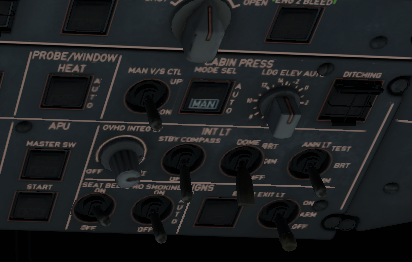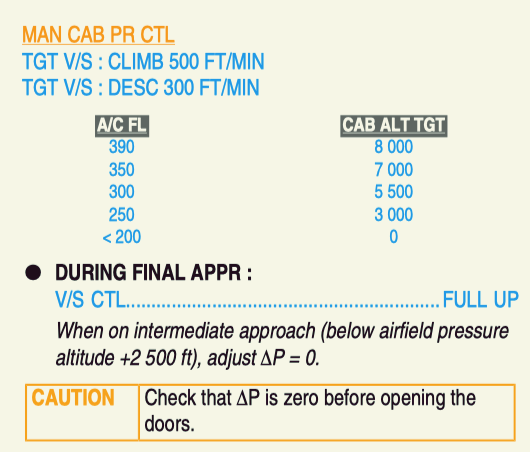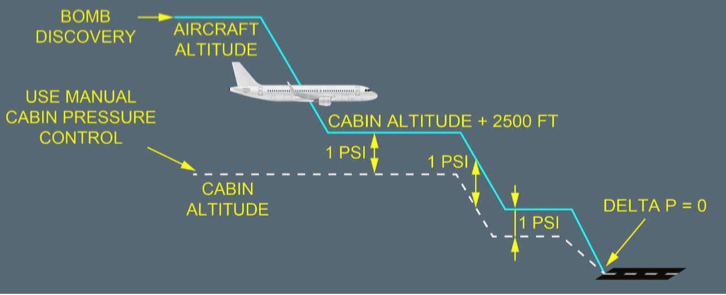Disclaimer:
▪︎This content is Not an official document and does not represent the views of Airbus or any other aviation authority.
▪︎The information provided may be incorrect or misinterpreted and should not be relied upon for decision-making.
▪︎Always refer to official documents and consult with a qualified aviation professional before making any decisions based on the information provided in this blog post.
▪︎The information provided in this blog post is based on personal study and review.
There is a manual V/S control knob which can be used after selecting the cabin pressure mode selector manual mode.
Can you recall whether it should notch down or notch up in case of a 'Cabin pressure system failure'?
To control the cabin pressure manually, we should remember that the aircraft is constantly pressurized through the bleed air system of the aircraft unless there is a system failure of the bleed or pneumatic systems. etc.
It depends on each situation how it might need the cabin altitude, but basically, notch down of the manual V/S control knob will move the outflow valve to the closed position, resulting in the cabin V/S going down.
Notch up will move the outflow valve to the open position, resulting in the cabin V/S going up.


it sounds simple after this explanation , but the situation varies with the situation.
MANUAL CONTROL OF CABIN ALTITUDE FROM CRUISE
To manually control the cabin system from cruise, use the manual V/S CTL toggle switch.
During cruise and before descent, the first notch down of the V/S control switch will be needed.
A couple of taps would be enough, then monitor cabin altitude, targeting the following table.
(It will be shown on the status pages or can be found in the FCOM)

Initially, the aircraft altitude will be much higher (cruise altitude) than the cabin altitude.
But as the aircraft altitude decreases, the cabin altitude will also decrease until there is a moment when the cabin altitude matches the aircraft altitude.
This indicates that the delta pressure (pressure difference between the aircraft and the outside) is approaching zero.

From cruise altitude until this moment, you were trying to maintain the target cabin altitude by notching down.
However, now the situation is the opposite because the delta pressure is nearing zero and there is no longer a difference between cabin altitude and aircraft altitude. Therefore, we can notch up and fully open the outflow valve until it indicates fully up.

EMERGENCY DESCENT PROCEDURE
According to the FCTM, it states that the flight crew should initiate an emergency descent if they confirm that the cabin altitude and rate of climb are excessively high and not controllable.
it means that, just because the cabin altitude is abnormal, it does not necessarily mean that the flight crew has to initiate an emergency descent. There is also an ECAM advisory on the SD, and this advisory recommends CPC changeover followed by manual pressure control.
In the event of this advisory, what should you do with the manual control knob—notch down or notch up?
It would depend on the situation, but it's important to remember that the aircraft is constantly pressurizing the cabin with air. Turning the V/S knob up will release cabin altitude until it matches the aircraft altitude.
Notching down will close the outflow valve, causing the cabin altitude to decrease.(Higher pressure) If the actual aircraft altitude is higher than the cabin altitude, this action will increase the delta pressure.
BOMB ON BOARD PROCEDURE
There is another procedure that involves manual cabin pressure control.
This procedure requires maintaining the cabin altitude as the aircraft begins to descend.
In contrast to normal situations where manual cabin pressure adjustment is needed, the initial action in this procedure is to notch up the manual cabin pressure control toggle switch to keep the cabin altitude unchanged. As the aircraft descends, the cabin altitude remains constant until the aircraft altitude reaches 2500 feet higher than the initial cabin altitude. At this point, it is time to adjust the delta pressure to 1 psi.

During this descent after aircraft altitude is 2500ft higher than the cabin altitude, now the cabin altitude needs to decrease accordingly.
Therefore, it is necessary to notch down from this moment onward, allowing the aircraft to be pressurized until approach.
At this stage, it's time to select the cabin pressure mode selector to auto, enabling the CPC to automatically control the cabin altitude to 0.
'MANUEVERS' 카테고리의 다른 글
| Engine Damage (1) | 2024.05.13 |
|---|---|
| Effects of Slats and Flaps (2) | 2024.05.03 |
| MANAGEMENT OF ABNORMAL OPERATIONS (2) | 2024.04.24 |
| ENG OUT ACC altitude. (2) | 2024.04.02 |
| Wind correction (1) | 2024.01.24 |



